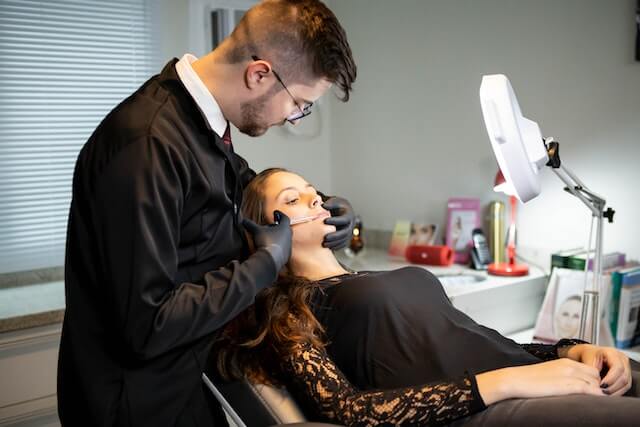If you’ve ever seen someone with a full, wrinkle-free under-eye area, there are two possibilities: either they have naturally beautiful eyes or they have hyaluronic acid fillers. Hyaluronic acid-infused topical serums and moisturizers deeply hydrate the skin to add volume, plumpness, and firmness, but HA fillers are a way to step things up (and get results right away), whether you’re trying to add volume to sunken under-eyes, lips, cheeks, or other areas. About this procedure, are you curious? We have included all the information on the hyaluronic acid fillers you require in the section above.
Hyaluronic acid fillers are a popular cosmetic treatment for reducing the appearance of wrinkles and fine lines. Hyaluronic acid is a naturally occurring substance found in the body that helps to maintain skin hydration and volume. Over time, the body’s natural levels of hyaluronic acid decline, leading to wrinkles and loss of skin elasticity.
Table of Contents
What are hyaluronic acid fillers?

Hyaluronic acid fillers are cosmetic treatments used to enhance the appearance of the face. They are injected into the skin to add volume and hydration, filling in wrinkles, fine lines, and hollow areas such as cheeks, temples, and under-eye hollows. Hyaluronic acid is a naturally occurring substance in the body that helps to maintain skin hydration and volume. Over time, the body’s natural levels of hyaluronic acid decline, leading to wrinkles and loss of skin elasticity. The fillers are considered safe, with a low risk of side effects.
Benefits of Hyaluronic Acid Fillers
- Reducing the appearance of wrinkles and fine lines: Hyaluronic acid fillers can help to smooth out wrinkles and fine lines, giving the skin a more youthful and refreshed appearance.
- Restoring volume: Fillers can be used to add volume to areas of the face that have lost volume over time, such as the cheeks, temples, and under-eye hollows.
- Non-invasive: Unlike surgical procedures, Hyaluronic acid fillers are non-invasive and require no downtime, making them a convenient option for those looking to enhance their appearance.
- Immediate results: The results of Hyaluronic acid filler treatments are immediate, with no need to wait for weeks or months to see the effects.
- Low risk of side effects: Hyaluronic acid fillers have a low risk of side effects, such as redness, swelling, and bruising, and are considered a safe cosmetic treatment.
- Customizable: The amount of filler used and the areas treated can be adjusted to suit the individual’s needs and preferences, allowing for a more personalized treatment experience.
- Temporary: If the individual is unhappy with the results, the effects of HA fillers are temporary and will wear off over time.
How hyaluronic acid fillers are done?
HA fillers are injected into the skin, where they add volume and hydration to the targeted area. The fillers work by filling in wrinkles, fine lines, and hollow areas in the face, such as the cheeks, temples, and under-eye hollows. The result is a more youthful, refreshed appearance. The procedure for having hyaluronic acid (HA) fillers typically includes the following steps:

- Consultation: Before the treatment, the individual will have a consultation with a dermatologist or plastic surgeon to determine the best type of Hyaluronic acid filler for their needs and discuss their cosmetic goals.
- Cleaning the area: The treatment area will be cleaned and sanitized to reduce the risk of infection.
- Numbing the area: A topical anesthetic or numbing cream may be applied to the treatment area to reduce any discomfort.
- Injection of filler: The Hyaluronic acid filler is injected into the skin using a fine needle or cannula. The dermatologist or plastic surgeon will carefully place the filler in the desired areas, taking care to avoid damaging any surrounding tissues.
- Massaging the area: After the filler is injected, the dermatologist or plastic surgeon may massage the treatment area to help distribute the filler evenly and avoid any lumps or bumps.
- Aftercare: The individual may be given aftercare instructions, such as avoiding excessive sun exposure and not engaging in physical activity for a period of time, to minimize any risks or side effects.
The entire procedure usually takes between 30 minutes to an hour, and the individual can typically return to their normal activities immediately after the treatment.
Hyaluronic Acid Fillers vs. Botox: what is the difference?
The fact that hyaluronic acid (HA) is present in the body naturally sets HA fillers apart from Botox. Another distinction between Botox and HA is how they handle the issue of aging. In contrast to neurotoxins (like Botox) that “freeze” the muscles to minimize wrinkles, HA fillers like Hyaluronic smooth the skin by filling in creases and boosting fullness. While botox temporarily paralyzes the underlying muscle to prevent the formation of static lines, HA acts to temporarily fill regions of volume loss and plump fine lines and wrinkles to make them almost undetectable. As a result, there is no need for filler.

How long do hyaluronic acid fillers last?
The duration of results from hyaluronic acid (HA) fillers can vary but typically lasts between 6 to 12 months. The specific lifespan of HA fillers depends on several factors, including the type of product used, the area treated, and the individual’s skin metabolism. Lifestyle factors, such as sun exposure and smoking, can also impact the longevity of the results.
What are the risks of hyaluronic acid injections?
Hyaluronic acid (HA) injections are generally considered safe and have few serious side effects. Some of the common side effects of HA injections include:
- Bruising: Injection sites can become bruised, especially if the needle is not inserted correctly.
- Swelling: Swelling is a common side effect and usually subsides within a few days.
- Pain: Pain during the injection can occur and can be managed with local anesthetics or numbing agents.
- Allergic reactions: Although rare, some individuals may experience an allergic reaction to the HA filler or other components of the product.
- Lumps and bumps: In some cases, HA fillers may form lumps or bumps under the skin. This can be resolved by massaging the area or by having the filler dissolved by a healthcare professional.
Surprising Benefits Of Hyaluronic Acid On Skin!
9 Best Retinol Face Serums for Healthy Skin
Concealer or Foundation First: Which is better?
